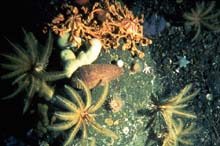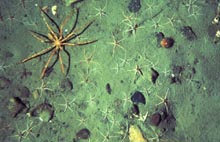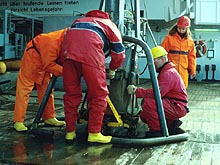
A rich benthic community in the European Arctic. Feather stars, basket stars, this particular sea cucumber (all in the group of echinoderms) and anemones prefer hard bottom as a substrate. (Photo courtesy of v. Juterzenka, Piepenburg, Schmid). Click image for larger view.

Brittle stars dominate vast areas of the investigated Arctic sea floor. The locally high abundance and biomass is determined by the amount of food available and is sustained by only few species. (Photo courtesy of v. Juterzenka, Piepenburg, Schmid). Click image for larger view.

These scientists are working on a box core. A box core works like a cookie cutter for sediment. It removes a piece of the sea floor with all the animals in and on it. Here, the sample has been taken and the metal sides of the core are screwed back together to prepare for the next cast. Click image for larger view.
Deep Sea Benthos
Bodil Bluhm
Research Assistant Professor of Marine Biology
School of Fisheries and Ocean Sciences
University of Alaska, Fairbanks
Katrin Iken
Assistant Professor of Marine Biology
University of Alaska, Fairbanks
Life on the Arctic Deep Sea Floor
Animals that live on the sea floor are called benthos. Most of these animals lack a backbone and are called invertebrates. Typical benthic invertebrates include sea anemones, sponges, corals, sea stars, sea urchins, worms, bivalves, crabs, and many more.
Recent research indicates that the diversity of species living in the deep-sea may rival the species richness found in tropical coral reefs! At first, scientists found this puzzling because we believed that few lifeforms could withstand the harsh, deep regions of the oceans. However, now we know that marine benthic organisms are well adapted to their environment and can live and thrive even in the cold dark waters of the deep sea.
These animals adapt to permanently low temperatures such as those found in the Arctic by having low metabolic rates. This means that organisms in cold waters live and work at a "lower speed” than organisms in warmer waters. This does not mean, however, that deep-sea organisms do not do as well as organisms from warmer waters. Rather, cold-adaptation means that these animals' enzymes and metabolic processes work best at ambient low temperatures and at high pressure. Most marine invertebrates lack gas-filled body compartments (like lungs in humans) that would collapse at high pressure. Thus, most deep-sea organisms would die in tropical temperatures or if they were kept in an aquarium. They would need to be kept in special pressurized tanks.
Many deep-sea organisms, including organisms in polar regions, also grow very slowly. In fact, some arctic deep-sea organisms grow as much in 10 years as some tropical organisms grow in one year! This means that polar and deep-sea species live to be much older than tropical species. A polar sea urchin can get as old as your grandmother, but a tropical one would likely die before its 10th birthday.
Going Hungry at Depth
Food availability strongly determines how well Arctic benthic organisms and communities will develop and grow. Sunlight usually cannot reach below 200 ft, which prevents marine micro- and macro-algae—significant food sources—from growing on the deep sea floor. Hence, sea floor animals depend primarily on food particles that rain down from the top of the water column or are transported downward along the continental slopes. A good portion of this “food rain” is eaten by animals in the water column, leaving the deep-sea creatures with what little remains.
Deep-sea areas, therefore, tend to be areas of limited food availability and often have “bad quality” food. Moreover, ice-covered areas get even less algal production than non-ice-covered areas, resulting in even less “food rain” for the Arctic deep-sea benthos.
The Arctic Ocean is characterized by broad, shallow continental shelf areas (average depth around 50m) which are often nutrient-rich and biologically active. Some shelf areas of the North American Arctic are teeming with benthic life such as worms, bivalves and crustaceans, which have been studied extensively. However, we know little about benthic communities at deeper areas of the Arctic Ocean, especially the Canadian Basin with depths around 3000 m. The long seasonal ice cover and the great depth render the sea floor of the deep Arctic Ocean extremely hard and expensive to access and sample. Only now do we have adequate ships and equipment to venture into these habitats – but the deep Arctic Ocean remains a challenge.
Our GoalsFor this expedition, we hope to observe and identify Arctic deep-sea fauna and explore their food web. A remotely operated vehicle (ROV) on board will be our eye at the sea floor. For the first time, we will see what kind of organisms manage to live in this extreme habitat, and how abundant they are. These in situ (onsite) and real-time observations also will tell us something about their lifestyle and hopefully their feeding habits. By using ROV technology, we expect to discover species that have not yet been seen in this area or may even be new to science. These collections may change our current view of the seemingly impoverished Arctic deep-sea fauna.
Our second objective is to learn about the benthic food web of the deep Arctic benthic community. Even with the use of an ROV, it will be a rare and lucky occasion if we are able to observe this. Thus, to augment our observational data, we plan to study naturally occurring isotopes, in particular carbon and nitrogen isotopes, to determine relative trophic positions of species on the broad scale of communities or ecosystems. During this expedition, we hope to trace food sources and follow organic matter flowing through the triangle of the pelagic, the sea ice and the benthos. The results will tell us which species feed on relatively fresh material (good quality food), which feed on other animals, and which survive on old, reworked detritus (bad quality food). The food web analysis of a whole ecosystem will help us identify key players as well as environmental key factors in the largely unexplored Arctic deep-sea ecosystem.Click here for more information on recent expeditions studying deep-sea Benthos: Diving to Extremes ![]()
Sign up for the Ocean Explorer E-mail Update List.


























